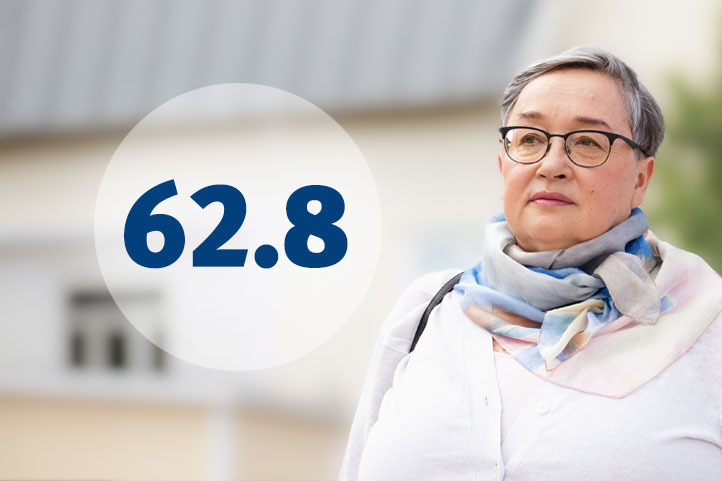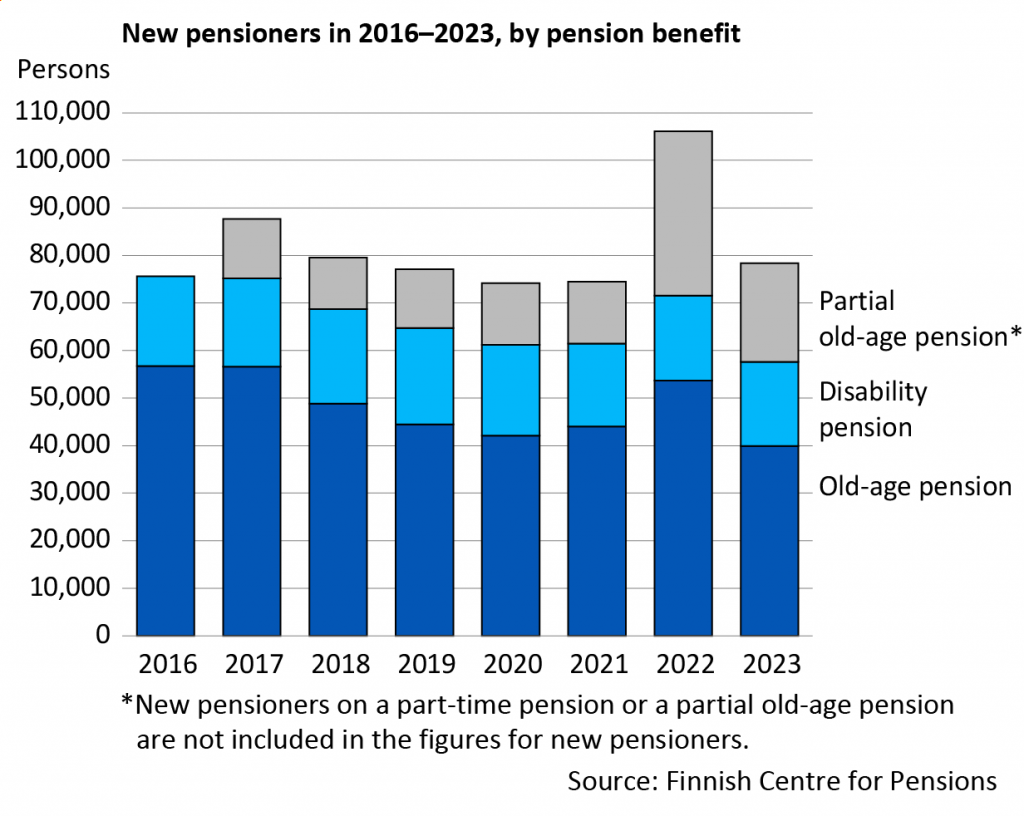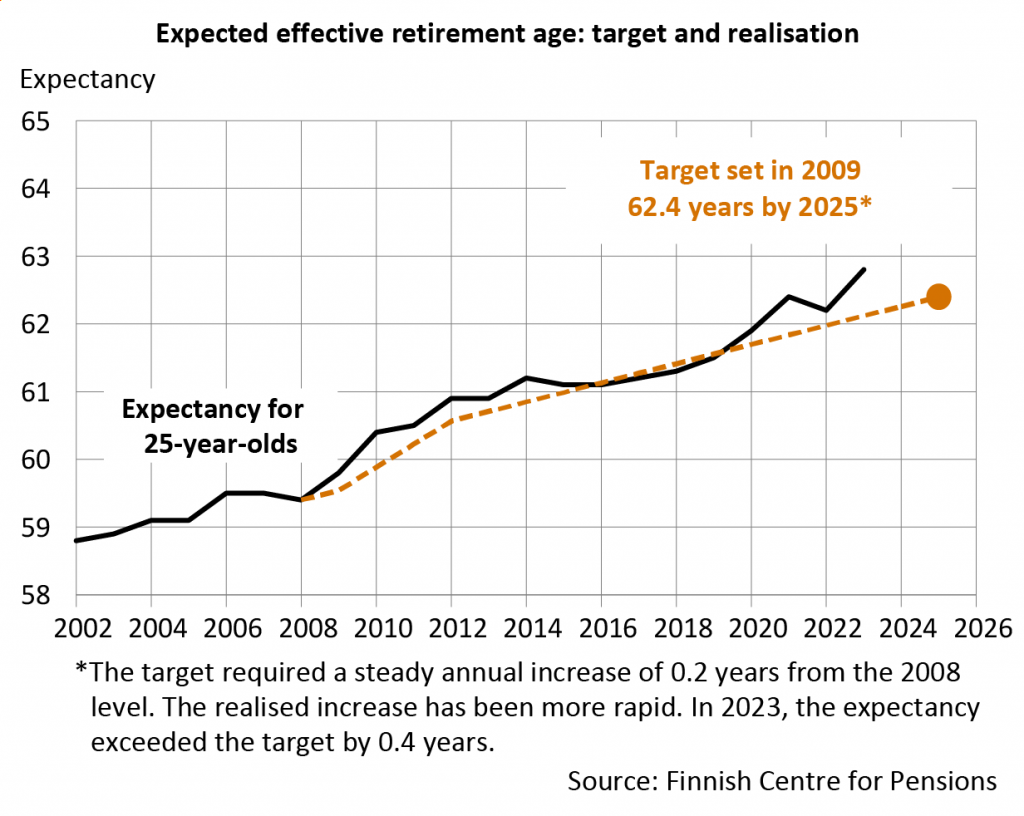Effective retirement age above target

Finns continue to extend their working lives. Last year, the average effective retirement age was 62.8 years. At the same time, the number of new pensioners fell significantly.
The expected effective retirement age in Finland has risen rapidly in recent years. According to the latest statistics from the Finnish Centre for Pensions, the average expected retirement age in 2023 was 62.8 years, an increase of more than half a year compared with the previous year.
Two factors explain the increase in the expected effective retirement age.
First, the number of people starting to draw an old-age pension in 2023 fell significantly due to the increase in the retirement age, which means that not all people born in 1959 reached their retirement age in 2023.
Another important factor is the indexation.
“The exceptionally large increase in the pension index at the beginning of last year led many people to bring forward their retirement to the year 2022. This increased the number of people who retired in 2022 and reduced the number of old-age pensions that started in 2023″, says Development Manager Jari Kannisto (Finnish Centre for Pensions).
In 2023, only 40,000 people drew the old-age pension. That is 25 per cent less than the year before.
“The number of people opting for a partial old-age pensions also fell sharply. There were still more than 20,000 of them, but they are not counted as pensioners in the statistics”, Kannisto points out.

Expected effective retirement age has risen surprisingly fast
The expected effective retirement age is a key indicator for pension policy. The target was set in the agreement between the social partners and the government on the pension dispute. The agreement was first reached in March 2009. Since then, the target has been reaffirmed in Katainen’s government programme.
According to the target, the expected effective retirement age should rise to at least 62.4 years by 2025. This target has been achieved ahead of schedule. In 2023, the effective expected retirement age exceeded the target by 0.4 years.
“We are at the finish line, and a little further into the lap of honour. The increase in the effective retirement age has been surprisingly rapid. The main reason is the increase in the retirement age for the old-age pension. The good employment situation has also contributed to the positive trend. The target was already reached in 2021, but the year before last the expectation fell slightly due to the high number of new pensioners,” says Jari Kannisto.

Graph as accessible table in Statistical Database
According to Kannisto, the development of this expectation will soon depend on economic and labour market developments. The number of people retiring in 2024 is expected to increase slightly from last year to just over 60,000.
The good employment situation has supported the trend in the retirement age, with the employment rate for 60–64-year-olds rising to a new record of almost 63 per cent last year. This was an increase of a few percentage points on the previous year. “In particular, there has been a rapid increase at the lower end of the retirement age, with the employment rate for those aged 64 already exceeding 40 per cent.”
Retirement age increases by age group
The retirement age increases in three-month increments for each age group.
This year, people born between 1 October 1959 and 30 June 1960 will reach their retirement age. Their retirement age is 64 years and 6 months.
In 2027, those born in 1962 will reach their retirement age of 65 years.
| Year of birth | Retirement age | The pension for the oldest person in the age group can start in |
|---|---|---|
| 1959 | 64 years 3 months | 2023 |
| 1960 | 64 years 6 months | 2024 |
| 1961 | 64 years 9 months | 2025 |
| 1962–1964 | 65 years | 2027 |
Expected life expectancy is calculated in the same way as life expectancy
Life expectancy at retirement measures the development of retirement in an earnings-related pension scheme.
It describes the average age at which people will retire, assuming that the pension contingency and mortality remain at the same level as in the reference year.
It is independent of the age structure of the population and is calculated according to the same principle as the expected life expectancy, which measures life expectancy.
Read more
- Effective retirement age in the earnings-related pension scheme (Etk.fi)
- Old-age pension: Birth year determines retirement age (tyoelake.fi)
- Pension calculator (tyoelake.fi)
